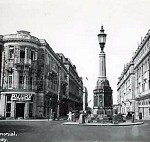A late morning walk through the leafy environs of Mumbai’s most well-planned business district, Ballard Estate, will inevitably draw one to the First World War Memorial erected by the erstwhile Bombay Port Trust in front of the gate of Alexander Docks, now renamed Indira Docks. On the memorial are the words – This memorial commemorates the employees of the Bombay Port Trust who fell during WW1, 1914-1918, and also the Port Trust’s contribution to the war effort.
This beautifully carved sandstone memorial, with brass plaques on three sides, is a reminder of the extent to which the city, especially her docks, was part of the Allied war efforts during the Great War. The numbers mentioned are staggering – 18,70,000 troops and personnel embarked and disembarked at the docks; 3,046 transports and 668 hospital ships dealt with, and 22,28,000 tons of military stores shipped from Bombay Port. The first transport ship left the city on 21 August, 1914, just 17 days after Britain entered the War.
The Port Trust railways also ran 2,073 troop and hospital trains to Bombay to facilitate troop movement and that of the injured to and from the city. And her docks repaired and refitted 494 ships involved in the war effort.
It was inevitable that once war broke out, the Bombay Harbour and her ports would be critical to the success of the Allied efforts in the eastern war theatre, particularly in West Asia and Africa, where many thousands of Indian soldiers fought valiantly for the Allied Powers against the Central Powers (Germany, Austro-Hungarian Empire, Turkey, and Russia).
The city was a fulcrum for the war effort, as it had not just an expansive, sheltered harbour and the best port facilities east of the Suez, but was also the headquarters of the Royal Indian Marine that played a critical role. Many of the RIM ships, supported ably by the merchant navy, fought in the waters of the Tigris and the Euphrates, off the coast of East Africa, and more notably Bombay’s HMIS Hardinge fought valiantly against the Turks to thwart their efforts to blockade the Suez Canal.
A Watery Grave
A visit to a little known First World War Memorial located in the Indian Sailor’s Home Society at Masjid Bunder gives an insight into the lives of the sailors who died fighting the war. A stately, domed structure the Home which is located in the midst of rows of warehouses between Delhi Street and Thana Street, is literally in the gut of the city.
The memorial’s caretaker is Binoy Nakulan who is the resident manager of the Sailor’s Home. He informs me that the site is maintained by the Commonwealth War Graves Commission and is listed as a WWI memorial on their website. It lies exactly under the dome of the Home and its circular ceiling has the adage Heaven’s Light Our Guide’ as well as the motto of the five-pointed Star of India, an insignia used on the Imperial Indian blue flag of the Royal Indian Marines.
Also written in bold is the line – Here are recorded in lasting honour and the remembrance the names of the 2223 seamen of the Royal Navy, the Royal Indian Marine and the Merchant Navy who fell in the Great War and whose grave is the sea.
The walls are lined with brass plaques listing the names of the deceased sailors in alphabetical order alongwith the names of the ships they belonged to. A recent addition is a World War II Memorial in the form of a brass casket enclosing a book commemorating the names of 6,531 lives lost at sea.
For naval history buffs, the flags that line this octagonal hall will be of great interest. There are the old flags of the Royal Indian Marine (blue ensign with the `Star of India’), the Royal Indian Navy (white ensign), the merchant navy, and the Royal Navy.
The pristine silence and the church-like quality of the dome with its skylight, add to the solemnity. It is well worth the effort to discover this little known gem of Mumbai – living a reminder of how deep an impact a war in Europe one hundred years ago had on the lives of over a million Indian soldiers and sailors. It was meant to be a war to end all wars, but as we all know history repeated itself just 21 years later.
Sifra Lentin is a Mumbai-based writer and historian, and the Mumbai History Fellow at Gateway House: Indian Council on Global Relations.
This blog was exclusively written for Gateway House: Indian Council on Global Relations. You can read more exclusive content here.
For interview requests with the author, or for permission to republish, please contact outreach@gatewayhouse.in.
© Copyright 2014 Gateway House: Indian Council on Global Relations. All rights reserved. Any unauthorized copying or reproduction is strictly prohibited


